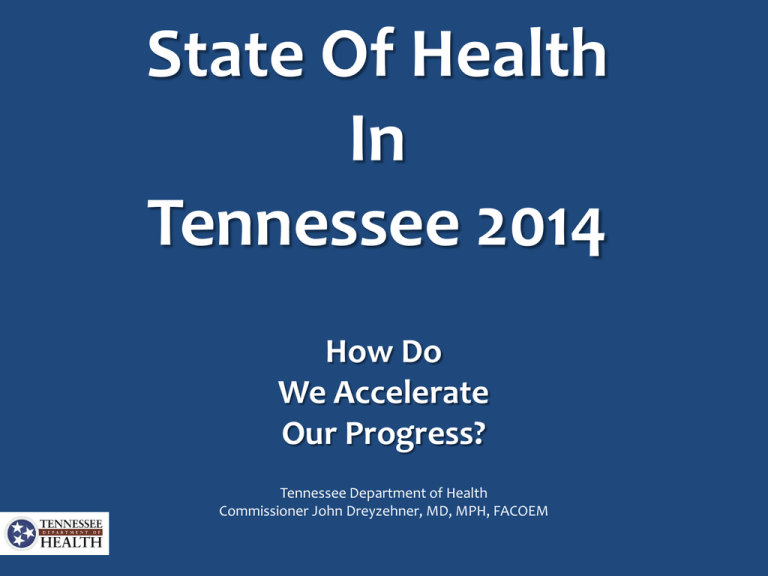Commissioner`s Address – Dr. John Dreyzehner
advertisement

State Of Health In Tennessee 2014 How Do We Accelerate Our Progress? Tennessee Department of Health Commissioner John Dreyzehner, MD, MPH, FACOEM Tennessee Department of Health Vision To be a respected and trusted leader, partnering and engaging to accelerate Tennessee to one of the nation’s ten healthiest states. In One Lifespan, Exceptional Work in Public Health And Advances in Medicine Combined to Make A Difference 1937 U.S. Life Expectancy: Approximately 62 years 2013 U.S. Life Expectancy: Approximately 78.5Years Tennessee: 76.4 Years In Tennessee in 1937: 1,072 people died from Tuberculosis 355(under age 2) died from Diarrhea/Enteritis 134 people died from Typhoid/Paratyphoid Fever 67 people died from Diphtheria 42 people died from Meningococcal Meningitis 40 people died from Whooping Cough 10 people died from Polio 7 people died from Measles Infant mortality rate was 59 per 1,000 live births State Population: 2,893,000 In Tennessee in 2013 15 people died from Tuberculosis 0 people died from Typhoid/Paratyphoid Fever 0 people died from Diphtheria 1 person died from Meningococcal Meningitis 1 person died from Whooping Cough 0 people died from Polio 0 people died from Measles 5 children (under 2) died from Diarrhea/Enteritis Infant mortality was 6.8 per 1,000 live births State Population: 6,496,000 Ten Greatest Achievements That Accelerated Public Health Progress in the United States in the 20th Century Vaccination Motor-vehicle safety Safer Workplaces Control of infectious diseases Decline in heart disease and stroke Safer and healthier foods Healthier mothers and babies Family planning Fluoridation of Drinking Water Recognition of tobacco use as a health hazard -- MMWR, December, 1999 Infant Mortality Rate in Tennessee – 1920-2014 12 11 8.8 8.7 8.3 Infant(718) Mortality Rate8.0 8.0 7.9 (733) 9 (718) (686) (655) Tennessee, 1920-2014* (626) Deaths per 1,000 Live Births (Number of Infant Deaths) 10 100 Deaths per 1,000 Live Births 90 86.9 80 74.9 70 8 7 7.4 7.2 (587) (576) 6.8 6.3 (542) (288) 6 5 4 3 2 1 60 53.2 0 2005 50 2006 2007 2008 2009 2010 2011 2012 2013 2014* 36.2 40 29.3 30 21.3 20 13.4 10 10.3 9.0 1990 2000 7.9 6.3 0 1920 1930 1940 1950 1960 1970 Year 1980 2010 Leading Causes of Death In Tennessee In 2013 1. 14,723 people died from heart disease 2. 13,931 people died from cancer 3. 3,897 people died from chronic lower respiratory diseases 4. 3,497 people died from accidents/adverse effects 5. 3,123 people died from cerebrovascular disease 6. 2,526 people died from Alzheimer's disease 7. 1,815 people died from diabetes mellitus 8. 1,551 people died from pneumonia and influenza 9. 1,059 Kidney disease/failure 10. 1,017 Suicide In 2013, 1,166 people in Tennessee died from drug overdoses Environment 5% Health Care 10% Health Behaviors 40% Genetics and Development 30% Social Factors 15% • Health care is not the primary driver of an individual’s overall health and well-being • Improving Health requires comprehensive focus: a public health approach 2014 Health Survey Ranks U.S. Last Among Rich Peers USA Today – June 17, 2014 Tennessee’s Health Ranking for 2013 Tennessee 2013 OVERALL RANKING: 42 Tennessee is 42nd this year It was 39th in 2012 2008 2009 2010 2011 2012 2013 30 35 39 40 45 50 44 48 42 41 42 Tennessee’s “Big Three” Tobacco Use U.S. Ranking: Physical Inactivity U.S. Ranking: Obesity U.S. Ranking: 47 45 40 These three directly influence seven of ten leading causes of death in Tennessee. To accelerate our progress, we must address the big three. Behavioral Risk Factor Surveillance System: Providing Beneficial Trend Data to Support Accelerated Efforts BRFSS data now include input from both landlines and cell phones, providing a more accurate sampling. It is the world’s largest on-going telephone health survey system – more than one-half million interviewed. Key Findings From the 2014 BRFSS Report Current Cigarette Smoking among Adults (18+ Years) Tennessee and the U.S., 2011-2013 40 35 Percent 30 24.9 25 20 U.S. 24.3 23.0 21.2 19.6 19.0 2012 2013 15 10 2011 TN Key Findings From the 2014 BRFSS Report No Exercise in Past 30 Days among Adults (18+ Years) Tennessee and the U.S., 2011-2013 40 37.2 35.1 35 Percent U.S. 30 TN 28.6 26.2 25.3 25 22.9 20 2011 2012 2013 Key Findings From the 2014 BRFSS Report Obesity among Adults (18+ Years), Tennessee and the U.S., 2011-2013 40 33.7 35 31.1 Percent 30 29.2 U.S. 29.4 25 27.8 27.6 2011 2012 20 15 10 2013 TN Obese/Overweight Tennessee Children: We Need To Accelerate BMI Reductions Overweight and Obesity Prevalence by Grade and School Year Tennessee Public Schools 50 45.4 44.3 43.9 44.1 41.1 40 39.1 38.6 38.5 43.4 42.7 42.4 42.0 40.6 40.6 34.8 34.6 33.5 Percent 40.9 40.5 30.0 30.9 30 20 10 0 All Grades* K* 2007-2008 2nd* 2011-2012 4th* 6th* 8th HS* 2012-2013 *The difference in prevalence between 2007-2008 and 2012-2013 was statistically significant. Source: Tennessee Department of Education TDH Customer Focused Government Plan • Primary Prevention Initiatives (PPI) • Tobacco Settlement Funding Effectiveness • Controlled Monitoring Substance Database – CSMD • America’s Health Rankings “Big 3” • Electronic Public Health Information System Primary Prevention Initiative Engages Communities to Promote Better Health Total Completed Projects: 360 Total PPI projects: 637 0 50 100 150 Obesity Tobacco Infant Mortality Immunization Substance Abuse Teen Pregnancy Other All 95 County Health Departments are participating in this initiative 200 Tobacco Settlement Funds Used to Help Protect Tennesseans 1. Eliminate smoking during pregnancy 2. Reduce infants’ and children’s exposure to second-hand smoke 3. Prevent child and adolescent tobacco use School Age Projects 3 8 65 33 14 123 operational projects Second Hand Smoke Exposure Projects 13 16 36 19 All 95 counties set own goals and projects 2 86 operational projects Pregnancy Smoking: Baby and Me Tobacco Free 42 5 53 64 operational projects 0 20 Amended for no action this year Planning and development activities Activity completed 40 60 80 Not started Active services 100 120 140 Prescription Safety & Population Protection Decrease in high-use patients since 3rd quarter 2012 Survey of 800 CSMD users found: • 71 % changed a treatment plan • 73 % were more likely to discuss substance abuse issues with a patient • 57 % were now more likely to refer a patient for substance abuse treatment Cumulative milligram morphine equivalent dispensed decreased Fig 1. Number of High Utilization Patients* in CSMD 2012-2014 • 0.7 percent in 2013 • 6.7 percent thus far in 2014 2500 2000 2012 1500 2013 2014 1000 500 0 1st quarter 2nd quarter 3rd quarter 4th quarter A New Tool To Combat Overdose Deaths: Naloxone Tennessee’s “Big Three” Tobacco Use U.S. Ranking: Physical Inactivity U.S. Ranking: Obesity U.S. Ranking: 47 45 40 These three directly influence seven of ten leading causes of death in Tennessee. To accelerate our progress, we must address the big three. Promoting Performance Excellence through our Baldrige Journey (TNCPE) Previous Year Winners Sullivan County Blount County Carter County Clay County Grundy County Hardin County Giles County Jackson County Rutherford County Wayne County Weakley County Office of Health Care Facilities Cancer Programs Collaborative Applicants for 2014: Montgomery County Greene County, Morgan and Roane counties Fayette, Hardeman, and McNairy counties Henderson and Decatur, Obion, Lake, and Dyer counties Overton County Putnam County Smith County Southeast Regional Office Northeast Regional Office Divisions of Policy, Planning, & Assessment Division of Information Technology Services Promising Accelerants for Health Progress in Tennessee Tobacco Settlement Prevention • Primary Prevention Initiative • Neonatal Abstinence Syndrome Subcabinet • Network of County Health Departments • Alliances with key external partners • Traumatic Brain Injury Awareness/Prevention • Immunizations Programs • Controlled Substance Monitoring Database • Vigorous Inspection Efforts – Food, Hotel/Motel/Pools – Other • Health Care Professionals – Licensing and Regulation • Public Health Training Created in 2013 by Governor Bill Haslam. Focus on exercise, diet and reducing tobacco use. January, 2014: Small Starts launched March, 2014: Launched Small Starts @ Work September, 2014: Small Starts @ Worship Continuing work with the Tennessee Department of Education to increase activity in the Extended Learning programs. • Co-chaired by Gov. Bill Haslam and First Lady Crissy Haslam • In its first full year, kidentraltn.com had 66,000 visitors seeking information about health, education and development • Kidcentraltn.com provides a directory of state-operated and state-funded services for children and families • Mobile app provides convenient access to information about services Preventing Injuries and Saving Lives On Tennessee’s Roads and Highways Governor’s Highway Safety Office & Department of Safety & Homeland Security The Department of Safety’s “Drive to Zero Fatalities” campaign seeks to reduce traffic deaths in Tennessee by 15 percent in 2014. Thanks to aggressive promotion, Tennessee’s percentage of vehicle fatalities involving motorists not wearing seatbelts is at a five-year low. Drive to 55 Education is linked to health: People with higher levels of education tend to be healthier, and people in good health tend to perform better in school Governor Bill Haslam launched the Drive to 55 to increase the number of Tennesseans with a certificate or degree beyond high school to 55 percent by the year 2025 in order to help build a strong workforce The Tennessee Promise TennCare Million Hearts: TennCare is a partner in the Million Hearts initiative to reduce the burden of heart disease Presumptive eligibility for newborns – allows participating hospitals and birthing centers to enroll newborns who mothers are not enrolled in TennCare at the time of delivery TennCare provides health care for 1.2 million Tennesseans and operates with an annual budget of $9 billion. Continuous Preparation To Protect Against Emerging Threats to Population Health: Invisible Services Communicable Diseases Ebola - Middle East Respiratory Syndrome - Chikunguna – SARS - LaCrosse Encephalitis - Polio - Measles - Rocky Mountain Spotted Fever West Nile Virus - Rabies - Dengue Fever – HIV/AIDS - Whooping Cough - Mumps Emergency Preparedness Tennessee Emergency Management Agency -- TN-CAT Tennessee Valley Authority – Generating Plant Accidents Oak Ridge National Laboratory – Materials Accidents Commissioner’s Charge “And thus we protect from ills and grief The rich man, poor man beggar and thief; For the robber, too, must be germ-free Lest he transmit to the other three.” -- 1937 TDH Annual Report ACCELERATE! Presentation by the Tennessee Department of Health Mission: Protect, promote and improve the health and prosperity of people in Tennessee. Tennessee Department of Health 710 James Robertson Parkway Nashville, TN 37243 Produced by the Tennessee Department of Health in September, 2014.






